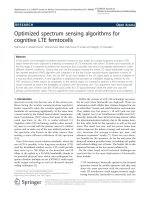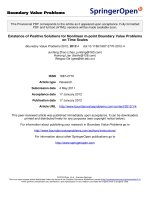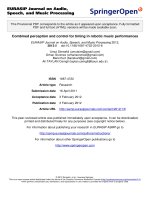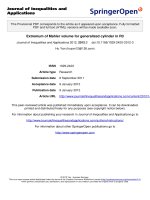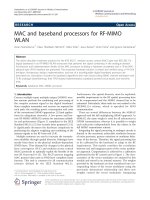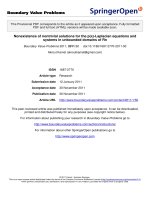Báo cáo toán học: " Highly selective fluorescent chemosensor for Zn2+ derived from inorganic-organic hybrid magnetic core/shell Fe3O4@SiO2 nanoparticles" pot
Bạn đang xem bản rút gọn của tài liệu. Xem và tải ngay bản đầy đủ của tài liệu tại đây (3.15 MB, 24 trang )
This Provisional PDF corresponds to the article as it appeared upon acceptance. Fully formatted
PDF and full text (HTML) versions will be made available soon.
Highly selective fluorescent chemosensor for Zn2+ derived from
inorganic-organic hybrid magnetic core/shell Fe3O4@SiO2 nanoparticles
Nanoscale Research Letters 2012, 7:86 doi:10.1186/1556-276X-7-86
Yujiao Wang ()
Xiaohong Peng ()
Jinmin Shi ()
Xiaoliang Tang ()
Jie Jiang ()
Weisheng Liu ()
ISSN 1556-276X
Article type Nano Express
Submission date 6 July 2011
Acceptance date 25 January 2012
Publication date 25 January 2012
Article URL />This peer-reviewed article was published immediately upon acceptance. It can be downloaded,
printed and distributed freely for any purposes (see copyright notice below).
Articles in Nanoscale Research Letters are listed in PubMed and archived at PubMed Central.
For information about publishing your research in Nanoscale Research Letters go to
/>For information about other SpringerOpen publications go to
Nanoscale Research Letters
© 2012 Wang et al. ; licensee Springer.
This is an open access article distributed under the terms of the Creative Commons Attribution License ( />which permits unrestricted use, distribution, and reproduction in any medium, provided the original work is properly cited.
- 1 -
Highly selective fluorescent chemosensor for Zn
2+
derived from
inorganic-organic hybrid magnetic core/shell Fe
3
O
4
@SiO
2
nanoparticles
Yujiao Wang
1
, Xiaohong Peng
1
, Jinmin Shi
1
, Xiaoliang Tang
1
, Jie Jiang
1
, and
Weisheng Liu*
1
1
Key Laboratory of Nonferrous Metals Chemistry and Resources Utilization of Gansu
Province and State Key Laboratory of Applied Organic Chemistry, College of
Chemistry and Chemical Engineering, Lanzhou University, Lanzhou, 730000,
People's Republic of China
*Corresponding author:
Email addresses:
YW:
XP:
JS:
XT:
JJ:
WL:
Abstract
Magnetic nanoparticles with attractive optical properties have been proposed for
applications in such areas as separation and magnetic resonance imaging. In this
paper, a simple and novel fluorescent sensor of Zn
2+
was designed with 3,5-di-tert-
butyl-2-hydroxybenzaldehyde [DTH] covalently grafted onto the surface of magnetic
core/shell Fe
3
O
4
@SiO
2
nanoparticles [NPs] (DTH-Fe
3
O
4
@SiO
2
NPs) using the
silanol hydrolysis approach. The DTH-Fe
3
O
4
@SiO
2
inorganic-organic hybrid
material was characterized by transmission electron microscopy, dynamic light
scattering, X-ray power diffraction, diffuse reflectance infrared Fourier transform,
UV-visible absorption and emission spectrometry. The compound DTH exhibited
fluorescence response towards Zn
2+
and Mg
2+
ions, but the DTH-Fe
3
O
4
@SiO
2
NPs
only effectively recognized Zn
2+
ion by significant fluorescent enhancement in the
presence of various ions, which is due to the restriction of the N-C rotation of DTH-
Fe
3
O
4
@SiO
2
NPs and the formation of the rigid plane with conjugation when the
DTH-Fe
3
O
4
@SiO
2
is coordinated with Zn
2+
. Moreover, this DTH-Fe
3
O
4
@SiO
2
fluorescent chemosensor also displayed superparamagnetic properties, and thus, it can
be recycled by magnetic attraction.
Background
Zinc is the second abundant transition metal ion in the human body, which plays a
vital role in various biological processes, such as gene expression [1], apoptosis [2],
enzyme regulation [3], and neurotransmission [4-5]. It is also believed that the Zn
2+
homeostasis may have some bearing on the pathology of Alzheimer's disease and
other neurological problems [6-8]. Therefore, there is an urgency to develop
approaches to detect Zn
2+
in vivo. Besides, techniques for the separation and removal
of metal ions and additives in the detection process are very important to prevent
- 2 -
poisoning in environmental and biological fields. Conventional analytical methods
including atomic absorption spectrophotometry [9], inductively coupled plasma
atomic emission spectrometry [10], and electrochemical method [11] can hardly be
applied for Zn
2+
ion detection in biological systems due to their complicated
pretreatment steps and expensive equipment. Hence, for convenience in future in vivo
applications, various fluorescent probes based on small molecules have been designed.
They were fairly efficient as reported [12-22]; however, the small molecules would be
toxic [23], and it is impossible to recover or remove them from organisms [24]. The
limitation of recoverability blocked the practical applications of small molecular
fluorescent probes. To resolve this challenge, the inorganic supports incorporated with
small molecular fluorescent probes were applied for the improvement on
recoverability.
Various mesoscopic or nanoscopic materials can be acted as the inorganic supports in
the design of fluorescent probes, including magnetic nanoparticles, nanotubes,
mesoporous silica, metal nanoparticles, and TiO
2
[25-34]. Among all these inorganic
materials, magnetic silica core/shell nanoparticles have advantages over other
competitors for biological and environmental applications [35-41]. Firstly, they could
be simply separated or recovered via external magnetic field. Besides, with magnetic
silica core/shell nanoparticles as delivery, their low toxicity and biocompatibility also
had advantages for the design of biological fluorescent probes. Furthermore, the silica
shell around magnetic core has large surface area, and it can be grafted by fluorescent
probes. Therefore, to develop nontoxic, biocompatible, and recoverable fluorimetric
Zn
2+
sensors, introducing the magnetic silica nanoparticles with small molecular
fluorescent probes incorporated is very necessary and highly desirable.
In this work, we designed and synthesized a magnetic recoverable fluorescence Zn
2+
sensor based on 3,5-di-tert-butyl-2-hydroxybenzaldehyde [DTH] covalently grafted
onto Fe
3
O
4
@SiO
2
nanoparticles [NPs] (DTH-Fe
3
O
4
@SiO
2
) to provide highly
selective fluorescence changes and efficient magnetic recoverability (Figure 1). This
Zn
2+
-selective fluorescent switch of the immobilized chemosensors displayed
excellent reversibility, combined with its superparamagnetic property, enabling the
recovery of material and repeated uses for Zn
2+
sensing.
Experimental details
Materials and methods
All reagents are purchased commercially. Besides, ethanol was used after purification
by standard methods. Other chemicals were used as received without further
purification.
Thermal gravimetric analysis [TGA] (P.E. Diamond TG/DTA/SPAECTRUN ONE
thermal analyzer, PerkinElmer Inc., Waltham, MA, USA), dynamic light scattering
(BI-200SM, Brookhaven Instruments Corporation, Holtsville, NY, USA),
transmission electron microscopy [TEM] (Tecnai G
2
F30, 300 kV, FEI Company,
OR, USA), and energy-dispersive X-ray spectrometer [EDX] were used to
characterize the materials. X-ray diffraction [XRD] pattern of the synthesized
products was recorded with a Rigaku D/MAX 2400 X-ray diffractometer (Tokyo,
Japan) using Cu Kα radiation (λ = 0.154056 Å). The scan range (2θ) was from 10° to
80°. Solid-state infrared [IR] using diffuse-reflectance infrared Fourier transform
- 3 -
[DRIFT] spectroscopy was performed in the 400- to 4,000-cm
−1
region using a Bruker
Vertex 70v (Bremen, Germany) and IR-grade KBr (Sigma-Aldrich Corporation, St.
Louis, MO, USA) as the internal standard.
1
H NMR and
13
C NMR spectra were
measured on a Bruker DRX 400 spectrometer in a CDCl
3
solution with TMS as the
internal standard. Chemical shift multiplicities are reported as s = singlet, t = triplet, q
= quartet, and m = multiplet. Mass spectra were recorded on a Bruker Daltonics
esquire6000 mass spectrometer. UV absorption spectra were recorded on a Varian
Cary 100 spectrophotometer (Palo Alto, CA, USA) using quartz cells of 1.0-cm path
length. Fluorescence measurements were made on a Hitachi F-4500
spectrophotometer (Tokyo, Japan) and a Shimadzu RF-540 spectrofluorophotometer
(Chorley, UK) equipped with quartz cuvettes of 1.0-cm path length with a xenon lamp
as the excitation source. An excitation and emission slit of 10.0 nm was used for the
measurements in the solution state. All spectrophotometric titrations were performed
with a suspension of the sample dispersed in ethanol.
Synthesis of Fe
3
O
4
@SiO
2
NPs
Fe
3
O
4
@SiO
2
NPs were synthesized according to the study of Nigam et al. [42].The
process can be briefly described in the following two steps: (1) FeCl
2
and FeCl
3
(molar ratio, 1:2) were added to a concentrated solution of base (25% ammonium
hydroxide) under N
2
. The solution was mechanically stirred for 1 h at 20°C and then
heated at 70°C for 1 h. The mixture was then stirred for 30 min at 90°C upon addition
of citric acid (0.5 g/ml). After cooling the reaction mixture to room temperature, the
magnetite NPs were obtained by permanent magnet, and then it was rinsed with
deionized water to remove excess citric acid and other nonmagnetic particles
thoroughly. (2) Then, the magnetite NPs were further coated with a thin silica layer
via a modified Stöber method [43] to obtain stable Fe
3
O
4
@SiO
2
. Tetraethyl
orthosilicate was hydrolyzed with magnetic NPs as seeds in an ethanol/water mixture.
The resulting silica-coated magnetite NPs with an average diameter of 60 to 70 nm
were used.
Synthesis of DTH-Fe
3
O
4
@SiO
2
NPs
As shown in Figure 1, the synthetic procedure for 2,4-di-tert-butyl-6-((3-
(triethoxysilyl)propylimino)methyl)phenol [DTH-APTES] followed the method
previously described in the literatures [44-45]. DTH (234 mg, 1 mmol) and (3-
aminopropyl) triethoxysilane [APTES] (221 mg, 1 mmol) were mixed in dry ethanol
(15 mL) at room temperature. Then, the solution was refluxed for 3 h under N
2
. After
that, the solvent was evaporated, and the crude product was further purified by flash
column chromatography (silica gel, ethyl acetate/petroleum ether 1:2) to produce 371
mg (84.9%) of DTH-APTES as yellow oil. ESI-MS: m/z 438.5 (M + H
+
).
1
H NMR:
(400 MHz, CDCl
3
): δ (ppm) 0.69 (t, 2H, CH
2
Si); 1.22 (t, 9H, CH
3
); 1.30 (s, 9H,
C(CH
3
)
3
); 1.43 (s, 9H, C(CH
3
)
3
); 1.82 (m, 2H, CH
2
); 3.58 (t, 2H, NCH
2
); 3.82 (q, 6H,
SiOCH
2
); 7.07, 7.36 (d, 2H, Ar); 8.34 (s, 1H, HC=N).
13
C NMR (100 MHz, CDCl
3
):
7.92 (CH
2
Si); 18.30 (CH
3
); 24.38, 29.40, 29.70, 31.50 (CH
3
); 34.11 (C), 35.01 (C);
58.41 (CH
2
); 62.08 (CH
2
); 117.83, 125.69, 126.66, 136.65, 139.75, 158.27 (Ar);
165.80 (C=N). FT-IR (KBr pellet) (cm
−1
): 1,637 (ν
C=N
), 1,275-1,252 (ν
C-O
), 1,596-
1,342 (ν
C=C
), 1,106-1,085 (ν
Si-O
).
One hundred milligrams of dried Fe
3
O
4
@SiO
2
NPs and 356 mg (0.81 mmol) of DTH-
APTES were suspended in 10 mL of anhydrous ethanol. The mixture was refluxed for
8 h at 80°C under N
2
to obtain DTH-Fe
3
O
4
@SiO
2
. The nanoparticles were collected
- 4 -
by centrifugation and repeatedly washed with anhydrous ethanol thoroughly.
Unreacted organic molecules were removed completely and monitored by the
fluorescence of the upper liquid. Then, the DTH-Fe
3
O
4
@SiO
2
NPs were finally dried
under vacuum over night. About 2.81% DTH-APTES in the precursors was finally
grafted on the NPs, and the rest could be recycled if no hydrolysis occurred.
Results and discussion
Characterization of DTH-Fe
3
O
4
@SiO
2
The TEM image (Figure 2A) of DTH-Fe
3
O
4
@SiO
2
reveals that iron oxide NPs have
entrapped in the silica shell successfully, in which the core/shell structures are in a
narrow size distribution of 60 to 70 nm [46-47], and the diameter of the magnetic core
is about 10 nm. The weight ratio of iron vs. silicon was measured to be 2.63:38.94 by
EDX. Hence, according to TGA, each magnetic NP has about 6,000
DTH-APTES
molecules grafted (see Additional file 1). More importantly, the right size of magnetic
core/shell NPs smaller than 100 nm is an advantage for their good dispersibility. In
addition, an inert silica coating on the surface of magnetite nanoparticles prevents
their aggregation in liquid [48]. Hence, such a good performance on the dispersibility
can improve their chemical stability and provide better protection against toxicity.
In addition, dynamic light scattering [DLS] was performed to further reveal the
colloidal stability of NPs. According to DLS results (Figure 2B), DTH-Fe
3
O
4
@SiO
2
presents good stabilization and a narrow size distribution with peak centered at 147
nm, confirming its good stabilization in ethanol. In a common sense, the diameter
achieved by DLS is mostly higher than the one observed in TEM since the size of NPs
identified by DLS includes the grafted molecules' steric hindering and the
hydrodynamic radius of first few solvent layers [49-51]. Besides, according to the
calculated size of DTH-APTES which covalently grafted on the surface of
Fe
3
O
4
@SiO
2
, the grafted molecules' steric hindering could increase the diameter by
about 2.72 nm.
Figure 3 shows the XRD powder diffraction patterns of two NPs for the identification
of Fe
3
O
4
in core/shell NPs. XRD patterns of the synthesized Fe
3
O
4
@SiO
2
(a) and
DTH-Fe
3
O
4
@SiO
2
(b) display relative diffraction peaks in the 2θ region of 10° to 80°.
We could find that XRD patterns show very low intensities for the peaks attributed to
the Fe
3
O
4
cores, due to the coating of amorphous silica shell, which deduced the
efficient content of Fe
3
O
4
cores and then affected the peak intensities. However, the
diffraction peaks of DTH-Fe
3
O
4
@SiO
2
still maintain the same position as the
magnetite core (Figure S1 in Additional file 1) [52]. The six characteristic diffraction
peaks in Figure 3 can be indexed to (220), (311), (400), (422), (511), and (440), which
well agree with the database of magnetite in the Joint Committee on Powder
Diffraction Standards [JCPDS] (JCPDS card: 19-629) file [42, 46, 53-54]. Also, the
broad XRD peak at a low diffraction angle of 20° to 30° corresponds to the
amorphous-state SiO
2
shells surrounding the Fe
3
O
4
NPs [53].
The successful conjugation of DTH onto the surface of the Fe
3
O
4
@SiO
2
NPs can be
confirmed by DRIFT (Figure 4). The bands at 3,400 to 3,500 cm
−1
and 1,000 to 1,250
cm
−1
are due to -OH stretching on silanol [55]. It indicates that not all the silanol on
Fe
3
O
4
@SiO
2
NPs have been covalently modified. The band at 1,630 cm
−1
represents
the bending mode of -OH vibrations [56]. DTH-Fe
3
O
4
@SiO
2
(see Figure 1) has
- 5 -
additional peaks at 2,918 and 2,850 cm
−1
that correspond to the -CH vibration of
aliphatic and aromatic groups [28, 57-58]. The bands at 1,473 and 1,463 cm
−1
of
DTH-Fe
3
O
4
@SiO
2
are probably due to the bending vibrations of -CH
3
, which come
from the DTH part [59]. According to the spectra of Fe
3
O
4
@SiO
2
and DTH-
Fe
3
O
4
@SiO
2
, the bands which appear as broad and strong and are centered at 1,102
(ν
as
) and 800 cm
−1
can be attributed to the siloxane (-Si-O-Si-) [60]. These results
support the presence of the organic DTH-APTES in the magnetic material DTH-
Fe
3
O
4
@SiO
2
.
The UV-visible [UV-Vis] spectra of DTH-APTES (1.0 × 10
−5
M), Fe
3
O
4
@SiO
2
(0.3
g/L), and DTH-Fe
3
O
4
@SiO
2
(0.3 g/L) can provide further evidence on the grafting of
DTH onto the surface of the Fe
3
O
4
@SiO
2
NPs (Figure 5). Compared to Fe
3
O
4
@SiO
2
(b), a new absorption band centered at about 330 nm of DTH-Fe
3
O
4
@SiO
2
can be
attributed to the typical electronic transition of an aromatic ring and -C=N- conjugate
system in a Schiff base molecule [29]. This result can also imply the successful
immobilization of DTH-APTES onto the magnetic core/shell NPs.
The superparamagnetic property of the magnetic NPs plays a vital role for its
biological application. Figure 6 shows the magnetization curves of the Fe
3
O
4
@SiO
2
and DTH-Fe
3
O
4
@SiO
2
which were investigated with a vibrating sample
magnetometer tuned from −15,000 to 15,000 Oe at 300 K. The result was consistent
with the conclusion that magnetic Fe
3
O
4
NPs smaller than 30 nm are usually
superparamagnetic at room temperature [47]. The saturation magnetization value for
synthesized DTH-Fe
3
O
4
@SiO
2
is about 3.96 emu/g. The saturation magnetization
value for Fe
3
O
4
@SiO
2
support was measured to be 4.24 emu/g. Considering the
grafting rate of 7.64% (according to TGA, Figure S2 and Table S1 in Additional file
1), the difference of saturation magnetization values between DTH-Fe
3
O
4
@SiO
2
and
its support could be due to the decreased weight ratio of magnetic support after
grafting. More importantly, from the hysteresis loops of Fe
3
O
4
@SiO
2
NPs and the
DTH-Fe
3
O
4
@SiO
2
NPs, it can be found that both exhibited superparamagnetic
properties for no remanence was observed when the applied magnetic field was
removed. These phenomena were due to the fact that the magnetite core is smaller
than 30 nm in core/shell NPs (Figure 2A). As a result of this superparamagnetic
property, DTH-Fe
3
O
4
@SiO
2
had a reversal magnetic responsivity. It could be easily
separated from dispersion after only 5 min using a magnet (Figure 6, inset) and then
redispersed by mild agitation when the magnet was removed. The reversal magnetic
responsivity of DTH-Fe
3
O
4
@SiO
2
would be a key factor when evaluating their
recoverability [61]. The magnetic separation capability of DTH-Fe
3
O
4
@SiO
2
NPs and
the reversibility of the combination between DTH-Fe
3
O
4
@SiO
2
and Zn
2+
could also
provide a simple and efficient route to separate Zn
2+
rather than through filtration
approach (see Figure 6 inset).
Fluorescence response of DTH-Fe
3
O
4
@SiO
2
To verify its fluorescence response towards various metal ions, we investigated
fluorescence properties of DTH-Fe
3
O
4
@SiO
2
NPs (0.3 g/L, containing 5.2 × 10
−5
M
DTH-APTES according to TGA in Figure S2 and Table S1 in Additional file 1)
towards various metal ions Ag
+
, Ca
2+
, Cd
2+
, Co
2+
, Cr
3+
, Cu
2+
, Fe
3+
, Hg
2+
, K
+
, Mg
2+
,
Mn
2+
, Na
+
, Ni
2+
, and Zn
2+
in ethanol solution (all as perchlorates, 1.0 × 10
−4
M). As
shown in Figure 7A, DTH-Fe
3
O
4
@SiO
2
NPs exhibited significant ‘off-on’ changes in
fluorescence emission only for Zn
2+
, but not for the others. It is noted that Cd
2+
with a
- 6 -
d
10
electron configuration, which often exhibited coordination properties similar to
Zn
2+
[19], do not influence the fluorescence intensity of DTH-Fe
3
O
4
@SiO
2
NPs
significantly. As a comparison, DTH (1.0 × 10
−5
M) exhibited fluorescence response
towards both Zn
2+
and Mg
2+
ions (1.0 × 10
−4
M) in the same solution, which is not as
selective as DTH-Fe
3
O
4
@SiO
2
for Zn
2+
detection (Figure 7B). Compared to the single
aldehyde DTH, the origin of selectivity for DTH-Fe
3
O
4
@SiO
2
may come from its
Schiff base structure, which prefers to coordinate with Zn
2+
under the interference of
Mg
2+
.
The remarkable increase of fluorescence intensity can be explained as follows: DTH-
Fe
3
O
4
@SiO
2
is poorly fluorescent due to the rotation of the N-C bond of DTH-
APTES part. When stably chelated with Zn
2+
, the N-C rotation of DTH-APTES part
is restricted and the rigid plane with conjugation is formed and the fluorescence
enhanced, which consists of our previous work [62]. The emission spectra of DTH-
Fe
3
O
4
@SiO
2
, which is excited at 397 nm, exhibit the emission maximum at 452 nm
with a low quantum yield (Φ = 0.0042) at room temperature in ethanol. Upon the
addition of excess Zn
2+
, the fluorescence intensity of DTH-Fe
3
O
4
@SiO
2
increased by
more than 25-fold, the emission maximum shifts from 452 to 470 nm, and the
quantum yield (Φ = 0.11) results in a 26-fold increase.
As illustrated in Figure 8A, the fluorescence emission of DTH-Fe
3
O
4
@SiO
2
(0.3 g/L)
increases gradually when adding various concentrations (0 to 30 µM) of Zn
2+
in
ethanol, indicating that Zn
2+
is quantitatively bound to the Schiff base moiety attached
to the NPs. Fluorescence titration experiment suggests that the association constant
(K
d
) for Zn
2+
binding to DTH-Fe
3
O
4
@SiO
2
is calculated to be 51.08 M
−2
(log K =
1.71; Figure 8A). Job's plot suggested a 1:2 binding ratio for Zn
2+
with DTH-APTES
(Figure 8B).
The competition experiments indicated that the presence of most metal ions,
especially Na
+
, K
+
, Ca
2+
, and Mg
2+
, which are abundant in the biological
environment, had a negligible effect on Zn
2+
sensing (Figure 9A). Since Cr
3+
, Cu
2+
,
Fe
3+
, and Hg
2+
also appeared to bind DTH-Fe
3
O
4
@SiO
2
sensors (Figure S3 in
Additional file 1), they quenched the fluorescence of the Zn
2+
-DTH-Fe
3
O
4
@SiO
2
,
owing to an electron or energy transfer between the metal cation and fluorophore
known as the fluorescence quenching mechanism [63-66]. The fluorescence
enhancement that occurred upon exposure to Zn
2+
was fully reversible as the addition
of EDTA (2.5 × 10
−4
M; Figure 9B and inset) restored the emission band. Combined
with its magnetic property, the results above implied that DTH-Fe
3
O
4
@SiO
2
was
considerably applicable to some field as a new inorganic-organic hybrid sensor for the
Zn
2+
ion.
Figure 10A depicts the UV-Vis diffuse reflectance spectra of DTH-APTES (10 µM),
DTH-APTES (10 µM) + Zn
2+
(100 µM), DTH-Fe
3
O
4
@SiO
2
(0.3 g/L), and DTH-
Fe
3
O
4
@SiO
2
(0.3 g/L) + Zn
2+
(100 µM). It can be seen that the absorbance peaks at
around 390 nm are formed when Zn
2+
is added in both DTH-APTES and DTH-
Fe
3
O
4
@SiO
2
systems. The absorption spectra of DTH-Fe
3
O
4
@SiO
2
(0.3 g/L) in the
presence of various concentrations of Zn
2+
(0 to 240 µM) were investigated in ethanol
at room temperature, as shown in Figure 10B. When Zn
2+
was added gradually, the
absorbance of DTH-Fe
3
O
4
@SiO
2
at 390 nm gradually increases, which indicated that
DTH-Fe
3
O
4
@SiO
2
NPs coordinated with Zn
2+
gradually.
- 7 -
Conclusions
In summary, we have successfully designed and synthesized functionalized magnetic
core/shell Fe
3
O
4
@SiO
2
NPs (DTH-Fe
3
O
4
@SiO
2
NPs) which could act as a new type
of fluorescent chemosensor for efficient sensing and separation of Zn
2+
in ethanol.
The inorganic-organic hybrid fluorescent chemosensor DTH-Fe
3
O
4
@SiO
2
was able to
recognize and adsorb Zn
2+
with a selective and sensitive fluorescence response in
ethanol. The magnetic separation capability of Fe
3
O
4
@SiO
2
NPs and the reversibility
of the combination between DTH-Fe
3
O
4
@SiO
2
and Zn
2+
would also provide a simple
route to separate Zn
2+
from the environment (Figure 6, inset).
Abbreviations
APTES, (3-aminopropyl)triethoxysilane; DLS, dynamic light scattering; DRIFT,
diffuse-reflectance infrared Fourier transform; DTH, 3,5-di-tert-butyl-2-
hydroxybenzaldehyde; DTH-APTES, 2,4-di-tert-butyl-6-((3-
(triethoxysilyl)propylimino)methyl)phenol; EDX, energy-dispersive X-ray
spectrometer; NPs, nanoparticles; TEM, transmission electron microscopy; TEOS,
tetraethyl orthosilicate; TGA, thermal gravimetric analysis; XRD, X-ray power
diffraction.
Competing interests
The authors declare that they have no competing interests.
Authors' contributions
YW supervised and participated in all the studies and wrote this paper. XP conceived
the study and participated in its design. JS participated in the synthesis of the
nanoparticles and the testing of fluorescence property. XT, JJ, and WL participated in
the revision of the manuscript. All authors read and approved the final manuscript.
Acknowledgments
The authors acknowledge the financial support from the NSFC (grant nos. 20931003
and 91122007) and the Specialized Research Fund for the Doctoral Program of
Higher Education (grant no. 20110211130002).
References
1. Falchuk KH: The molecular basis for the role of zinc in developmental biology.
Mol Cell Biochem 1998, 188:41.
2. Zalewski PD, Forbes IJ, Betts WH: Correlation of apoptosis with change in
intracellular labile Zn(II) using zinquin [(2-methyl-8-p-toluenesulphonamido-
6-quinolyloxy)acetic acid], a new specific fluorescent probe for Zn(II).
Biochem J 1993, 296:403.
3. Maret W, Jacob C, Vallee BL, Fischer EH: Inhibitory sites in enzymes: zinc
removal and reactivation by thionein. Proc Natl Acad Sci 1999, 96:1936.
4. Cuajungco MP, Lees GJ: Zinc metabolism in the brain: relevance to human
neurodegenerative disorders. Neurobiol Dis 1997, 4:137.
5. Choi DW, Koh JY: Zinc and brain injury. Annu Rev Neurosci 1998, 21:347.
6. Bush AI: Metals and neuroscience. Curr Opin Chem Biol 2000, 4:184.
7. Miller Y, Ma B, Nussinov R: Zinc ions promote alzheimer Aβ aggregation via
population shift of polymorphic states. Proc Natl Acad Sci 2010, 107:9490.
- 8 -
8. Duce JA, Tsatsanis A, Cater MA, James SA, Robb E, Wikhe K, Leong SL, Perez K,
Johanssen T, Greenough MA, Cho H-H, Galatis D, Moir RD, Masters CL, McLean
C, Tanzi RE, Cappai R, Barnham KJ, Ciccotosto GD, Rogers JT, Bush AI: Iron-
export ferroxidase activity of β-amyloid precursor protein is inhibited by zinc
in alzheimer's disease. Cell 2010, 142:857.
9. Li Q, Zhao X, Lv Q, Liu G: The determination of zinc in water by flame atomic
absorption spectrometry after its separation and preconcentration by
malachite green loaded microcrystalline triphenylmethane. Sep Purif Technol
2007, 55:76.
10. Wilhartitz P, Dreer S, Krismer R, Bobleter O: High performance ultra trace
analysis in molybdenum and tungsten accomplished by on-line coupling of
ion chromatography with simultaneous ICP-AES. Microchim Acta 1997,
125:45.
11. Gupta NR, Mittal S, Kumar S, Kumar SKA: Potentiometric studies of N,N'-
Bis(2-dimethylaminoethyl)-N, N'-dimethyl-9,10 anthracenedimethanamine
as a chemical sensing material for Zn(II) ions. Mater Sci Eng C 2008, 28:
1025.
12. Xu Z, Baek K-H, Kim HN, Cui J, Qian X, Spring DR, Shin I, Yoon J: Zn
2+
-
triggered amide tautomerization produces a highly Zn
2+
-selective, cell-
permeable, and ratiometric fluorescent sensor. J Am Chem Soc 2010, 132:601.
13. de Silva AP, Gunaratne HQN, Gunnlaugsson T, Huxley AJM, McCoy CP,
Rademacher JT, Rice TE: Signaling recognition events with fluorescent
sensors and switches. Chem Rev 1997, 97:1515.
14. Wong BA, Friedle S, Lippard SJ: Solution and fluorescence properties of
symmetric dipicolylamine-containing dichlorofluorescein-based Zn
2+
sensors.
J Am Chem Soc 2009, 131:7142.
15. Nolan EM, Lippard SJ: Small-molecule fluorescent sensors for investigating
zinc metalloneurochemistry. Acc Chem Res 2008, 42:193.
16. Zhang XA, Hayes D, Smith SJ, Friedle S, Lippard SJ: New strategy for
quantifying biological zinc by a modified zinpyr fluorescence sensor. J Am
Chem Soc 2008, 130:15788.
17. Zhang Y, Guo X, Si W, Jia L, Qian X: Ratiometric and water-soluble
fluorescent zinc sensor of carboxamidoquinoline with an alkoxyethylamino
chain as receptor. Org Lett 2008, 10:473.
18. Komatsu K, Urano Y, Kojima H, Nagano T: Development of an
iminocoumarin-based zinc sensor suitable for ratiometric fluorescence
imaging of neuronal zinc. J Am Chem Soc 2007, 129:13447.
19. Hanaoka K, Kikuchi K, Kojima H, Urano Y, Nagano T: Development of a zinc
ion-selective luminescent lanthanide chemosensor for biological applications.
J Am Chem Soc 2004, 126:12470.
20. Maruyama S, Kikuchi K, Hirano T, Urano Y, Nagano T: A novel, cell-permeable,
fluorescent probe for ratiometric imaging of zinc ion. J Am Chem Soc 2002,
124:10650.
21. Zhou X, Yu B, Guo Y, Tang X, Zhang H, Liu W: Both visual and fluorescent
sensor for Zn
2+
based on quinoline platform. Inorg Chem 2010, 49:4002.
22. Komatsu K, Kikuchi K, Kojima H, Urano Y, Nagano T: Selective zinc sensor
molecules with various affinities for Zn
2+
, revealing dynamics and regional
distribution of synaptically released Zn
2+
in hippocampal slices. J Am Chem
Soc 2005, 127:10197.
- 9 -
23. Marshall M, Draney D, Sevick-Muraca E, Olive D: Single-dose intravenous
toxicity study of IRDye 800CW in sprague-dawley rats. Mol Imaging Biol
2010, 12:583.
24. Herrmann IK, Urner M, Koehler FM, Hasler M, Roth-Z’Graggen B, Robert N.
Grass UZ, Beck-Schimmer B, Stark WJ: Blood purification using
functionalized core/shell nanomagnets. Small 2010, 6:1388.
25. Han WS, Lee HY, Jung SH, Lee SJ, Jung JH: Silica-based chromogenic and
fluorogenic hybrid chemosensor materials. Chem Soc Rev 2009, 38:1904.
26. Zheng J, Xiao C, Fei Q, Li M, Wang B, Feng G, Yu H, Huan Y, Song Z: A highly
sensitive and selective fluorescent Cu
2+
sensor synthesized with silica
nanoparticles. Nanotechnology 2010, 21:045501.
27. Lee SJ, Lee J-E, Seo JB, Jeong Y, Lee SS, Jung JH: Optical sensor based on
nanomaterial for the selective detection of toxic metal ions. Adv Funct Mater
2007, 17:3441.
28. Meng Q, Zhang X, He C, He G, Zhou P, Duan C: Multifunctional mesoporous
silica material used for detection and adsorption of Cu
2+
in aqueous solution
and biological applications in vitro and in vivo. Adv Funct Mater 2010,
20:1903.
29. Gao L, Wang Y, Wang J, Huang L, Shi L, Fan X, Zou Z, Yu T, Zhu M, Li Z: A
novel Zn
II
-sensitive fluorescent chemosensor assembled within aminopropyl-
functionalized mesoporous SBA-15. Inorg Chem 2006, 45:6844.
30. Son H, Lee HY, Lim JM, Kang D, Han WS, Lee SS, Jung JH: A highly sensitive
and selective turn-on fluorogenic and chromogenic sensor based on
BODIPY-functionalized magnetic nanoparticles for detecting lead in living
cells. Chem Eur J 2010, 16:11549.
31. Park M, Seo S, Lee IS, Jung JH: Ultraeffcient separation and sensing of
mercury and methylmercury ions in drinking water by using
aminonaphthalimide-functionalized Fe
3
O
4
@SiO
2
core/shell magnetic
nanoparticles. Chem Commun 2010, 46:4478.
32. Wang X, Wang P, Dong Z, Dong Z, Ma Z, Jiang J, Li R, Ma J: Highly sensitive
fluorescence probe based on functional SBA-15 for selective detection of
Hg
2+
. Nanoscale Res Lett 2010, 5:1468.
33. Chai F, Wang T, Li L, Liu H, Zhang L, Su Z, Wang C: Fluorescent gold
nanoprobes for the sensitive and selective detection for Hg
2+
. Nanoscale Res
Lett 2010, 5:1856.
34. Dong Z, Yang B, Jin J, Li J, Kang H, Zhong X, Li R, Ma J: Quinoline group
modified carbon nanotubes for the detection of zinc ions. Nanoscale Res Lett
2009, 4:335.
35. Corr SA, Rakovich YP, Gun'ko YK: Multifunctional magnetic-fluorescent
nanocomposites for biomedical applications. Nanoscale Res Lett 2008, 3:87.
36. Wang B, Hai J, Liu Z, Wang Q, Yang Z, Sun S: Selective detection of iron(III)
by rhodamine-modified Fe
3
O
4
nanoparticles. Angew Chem Int Ed 2010,
49:4576.
37. Bao F, Yao J-L, Gu R-A: Synthesis of magnetic Fe
2
O
3
/Au core/shell
nanoparticles for bioseparation and immunoassay based on surface-
enhanced raman spectroscopy. Langmuir 2009, 25:10782.
38. Babic M, Horák D, Trchová M, Jendelová P, Glogarová Ki, Lesný P, Herynek V,
Hájek M, Syková E: Poly(L-lysine)-modified iron oxide nanoparticles for
stem cell labeling. Bioconjugate Chem 2008, 19:740.
- 10 -
39. McCarthy JR, Bhaumik J, Karver MR, Sibel Erdem S, Weissleder R: Targeted
nanoagents for the detection of cancers. Molecular Oncology 2010, 4:511.
40. Taboada E, Solanas R, Rodriguez E, Weissleder R, Roig A: Supercritical-fluid-
assisted one-pot synthesis of biocompatible core (γ-Fe
2
O
3
)/shell(SiO
2
)
nanoparticles as high relaxivity T
2
-contrast agents for magnetic resonance
imaging. Adv Funct Mater 2009, 19:2319.
41. Guo N, Wu DC, Pan XH, Lu ML: Magnetic polymer microspheres with
azidocarbonyl groups: synthesis, characterization and application in protein
immobilization. J Appl Polym Sci 2009, 112:2383.
42. Nigam S, Barick KC, Bahadur D: Development of citrate-stabilized Fe
3
O
4
nanoparticles: conjugation and release of doxorubicin for therapeutic
applications. J Magn Magn Mater 2011, 323:237.
43. Stöber W, Fink A, Bohn E: Controlled growth of monodisperse silica spheres
in the micron size range. J Colloid Interface Sci 1968, 26:62.
44. Malumbazo N, Mapolie SF: Silica immobilized salicylaldimine Cu(II) and
Co(II) complexes as catalysts in cyclohexene oxidation: a comparative study
of support effects. J Mol Catal A: Chem 2009, 312:70.
45. Ray S, Mapolie SF, Darkwa J: Catalytic hydroxylation of phenol using
immobilized late transition metal salicylaldimine complexes. J Mol Catal A:
Chem 2007, 267:143.
46. Ma D, Guan J, Normandin F, DeÂnommeÂe S, Enright G, Veres T, Simard B:
Multifunctional nano-architecture for biomedical applications. Chem Mater
2006, 18:1920.
47. Lin Y-S, Haynes CL: Synthesis and characterization of biocompatible and
size-tunable multifunctional porous silica nanoparticles. Chem Mater 2009,
21:3979.
48. Laurent S, Forge D, Port M, Roch A, Robic C, Elst LV, Muller RN: Magnetic
iron oxide nanoparticles: synthesis, stabilization, vectorization,
physicochemical characterizations, and biological applications. Chem Rev
2008, 108:2064.
49. Zhang J, Li D, Liu G, Glover KJ, Liu T: Lag periods during the self-assembly
of {Mo
72
Fe
30
} macroions: connection to the virus capsid formation process. J
Am Chem Soc 2009, 131:15152.
50. Sethi M, Joung G, Knecht MR: Stability and electrostatic assembly of Au
nanorods for use in biological assays. Langmuir 2008, 25:317.
51. Arita T, Ueda Y, Minami K, Naka T, Adschiri T: Dispersion of fatty acid
surface modified ceria nanocrystals in various organic solvents. Ind Eng
Chem Fundam 2009, 49:1947.
52. Lai C-W, Wang Y-H, Lai C-H, Yang M-J, Chen C-Y, Chou P-T, Chan C-S, Chi Y,
Chen Y-C, Hsiao J-K: Iridium-complex-functionalized Fe
3
O
4
/SiO
2
core/shell
nanoparticles: a facile three-in-one system in magnetic resonance imaging,
luminescence imaging, and photodynamic therapy. Small 2008, 4:218.
53. Ren C, Li J, Chen X, Hu Z, Xue D: Preparation and properties of a new
multifunctional material composed of superparamagnetic core and
rhodamine B doped silica shell. Nanotechnology 2007, 18:345604.
54. Chen L, Xu Z, Dai H, Zhang S: Facile synthesis and magnetic properties of
monodisperse Fe
3
O
4
/silica nanocomposite microspheres with embedded
structures via a direct solution-based route. J Alloys Compd 2010, 497:221.
55. Mu L, Shi W, Chang JC, Lee S-T: Silicon nanowires-based fluorescence sensor
for Cu(II). Nano Lett 2008, 8:104.
- 11 -
56. Murthy RSS, Leyden DE: Quantitative determination of (3-
aminopropyl)triethoxysilane on silica gel surface using diffuse reflectance
infrared Fourier transform spectrometry. Anal Chem 1986, 58:1228.
57. Pal P, Rastogi SK, Gibson CM, Aston DE, Branen AL, Bitterwolf TE:
Fluorescence sensing of zinc(II) using ordered mesoporous silica material
(MCM-41) functionalized with N-(quinolin-8-yl)-2-[3-
(triethoxysilyl)propylamino]acetamide. ACS Appl Mat Interfaces 2011, 3:279.
58. Song C, Zhang X, Jia C, Zhou P, Quan X, Duan C: Highly sensitive and
selective fluorescence sensor based on functional SBA-15 for detection of
Hg
2+
in aqueous media. Talanta 2010, 81:643.
59. Sasithorn J, Wiwattanadate D, Sangsuk S: Utilization of fly ash from power
plant for adsorption of hydrocarbon contamination in water. J Met Mater
Miner 2010, 20:5.
60. Kim E, Kim HJ, Bae DR, Lee SJ, Cho EJ, Seo MR, Kim JS, Jung JH: Selective
fluoride sensing using organic–inorganic hybrid nanomaterials containing
anthraquinonew. New J Chem 2008, 32:1003.
61. Sun Y, Liu G, Gu H, Huang T, Zhang Y, Li H: Magnetically recoverable SiO
2
-
coated Fe
3
O
4
nanoparticles: a new platform for asymmetric transfer
hydrogenation of aromatic ketones in aqueous medium. Chem Commun 2011,
47:2583.
62. Peng X, Tang X, Qin W, Dou W, Guo Y, Zheng J, Liu W, Wang D:
Aroylhydrazone derivative as fluorescent sensor for highly selective
recognition of Zn
2+
ions: syntheses, characterization, crystal structures and
spectroscopic properties. Dalton Trans 2011, 40:5271.
63. Wu Z, Zhang Y, Ma JS, Yang G: Ratiometric Zn
2+
sensor and strategy for
Hg
2+
selective recognition by central metal ion replacement. Inorg Chem
2006, 45:3140.
64. Nolan EM, Burdette SC, Harvey JH, Hilderbrand SA, Lippard SJ: Synthesis and
characterization of zinc sensors based on a monosubstituted fluorescein
platform. Inorg Chem 2004, 43:2624.
65. Xue L, Wang H-H, Wang X-J, Jiang H: Modulating affinities of di-2-
picolylamine (DPA)-substituted quinoline sensors for zinc ions by varying
pendant ligands. Inorg Chem 2008, 47:4310.
66. Sarkar M, Banthia S, Samanta A: A highly selective ‘off-on’ fluorescence
chemosensor for Cr(III). Tetrahedron Lett 2006, 47:7575.
Figure 1. Syntheses of DTH-APTES and DTH-Fe
3
O
4
@SiO
2
.
Figure 2. TEM image (A) and the particle size histogram from DLS (B) of DTH-
Fe
3
O
4
@SiO
2
.
Figure 3. XRD patterns of Fe
3
O
4
@SiO
2
(a) and DTH-Fe
3
O
4
@SiO
2
(b).
Figure 4. DRIFT spectra of Fe
3
O
4
@SiO
2
(a) and DTH-Fe
3
O
4
@SiO
2
(b).
Figure 5. UV-Vis spectra of DTH-APTES (a), Fe
3
O
4
@SiO
2
(b), and DTH-
Fe
3
O
4
@SiO
2
(c).
- 12 -
Figure 6. Magnetization curves of the Fe
3
O
4
@SiO
2
(a) and DTH-Fe
3
O
4
@SiO
2
(b). Inset shows that DTH-Fe
3
O
4
@SiO
2
was dispersed to an external magnet in
ethanol.
Figure 7. Fluorescence response of DTH-Fe
3
O
4
@SiO
2
(A) and DTH (B) to
various cations. Excitation wavelength was 397 nm. Spectra were recorded every 25
min after adding Zn
2+
.
Figure 8. Fluorescence titrations and Job's plot. (A) Fluorescence titrations of
DTH-Fe
3
O
4
@SiO
2
with Zn
2+
. (B) Job's plot of DTH-APTES with Zn
2+
. Spectra were
recorded every 25 min after adding Zn
2+
.
Figure 9. Competition of DTH-Fe
3
O
4
@SiO
2
towards cations and reversibility of
DTH-Fe
3
O
4
@SiO
2
towards Zn
2+
. (A) Fluorescent emission changes of DTH-
Fe
3
O
4
@SiO
2
(0.3 g/L) upon addition of 1, blank; 2, Zn
2+
; 3, Na
+
; 4, Na
+
+ Zn
2+
; 5,
K
+
; 6, K
+
+ Zn
2+
; 7, Ca
2+
; 8, Ca
2+
+ Zn
2+
; 9, Mg
2+
; and 10, Mg
2+
+ Zn
2+
(each metal
ion is 100 µM) in ethanol at room temperature. (B) Fluorescence spectra of DTH-
Fe
3
O
4
@SiO
2
(0.3 g/L) in (a) without, (b) with Zn
2+
(1.0 × 10
−4
M), and (c) after
treatment with EDTA (2.5 × 10
−4
M) in (b) solution. The inset picture shows the
photograph of DTH-Fe
3
O
4
@SiO
2
with Zn
2+
by treatment of EDTA (2.5 × 10
−4
M)
under a 365-nm UV light.
Figure 10. UV-Vis spectra. (A) Absorption spectra of (a) DTH-APTES (1.0 × 10
−5
M), (b) DTH-APTES + Zn
2+
(1.0 × 10
−4
M), (c) DTH-Fe
3
O
4
@SiO
2
(0.3 g/L), and (d)
DTH-Fe
3
O
4
@SiO
2
(0.3 g/L) + Zn
2+
(1.0 × 10
−4
M) in ethanol. (B) UV-Vis spectra of
DTH-Fe
3
O
4
@SiO
2
(0.3 g/L) in ethanol in the presence of different amounts of Zn
2+
(0
to 240 µM).
Additional file
Additional file 1
Title: Characterization and properties of DTH-Fe
3
O
4
@SiO
2
.
Description: Figure S1, XRD patterns of Fe
3
O
4
core; Figure S2, TGA curves of
Fe
3
O
4
@SiO
2
(a) and DTH-Fe
3
O
4
@SiO
2
(b); Figure S3, selectivity of DTH-
Fe
3
O
4
@SiO
2
for Zn
2+
in the presence of other metal ions in ethanol; and Table S1, the
loading of DTH-APTES in the Fe
3
O
4
@SiO
2
NPs as estimated by different methods.
Figure 3
Figure 4
Figure 5
Figure 6
Figure 7
Figure 8
Figure 9
Figure 10
Additional files provided with this submission:
Additional file 1: supp1.doc, 202K
/>

